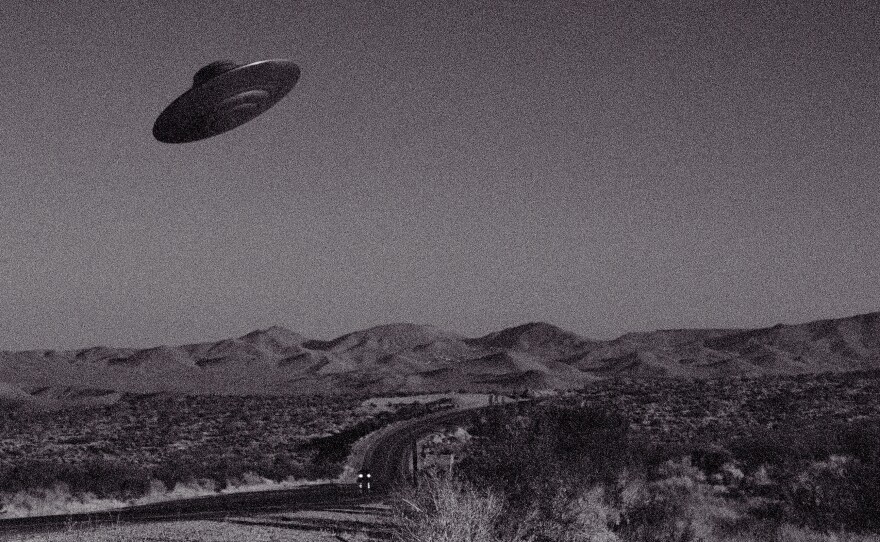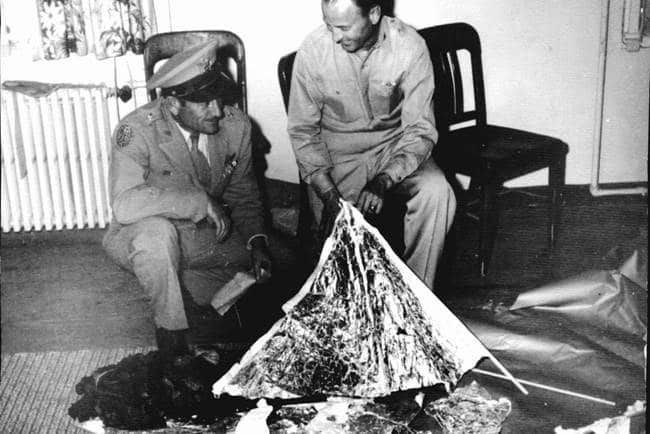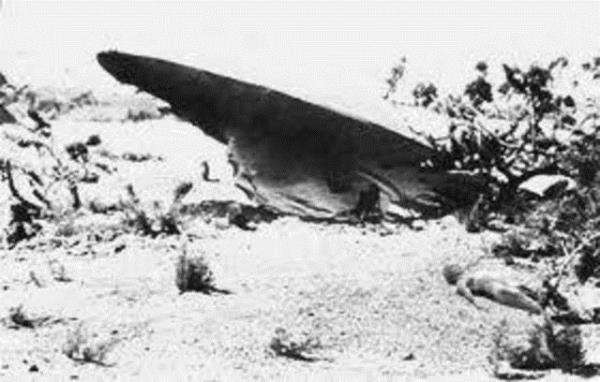In July 1947, on a hot summer day, a rancher found pieces of debris all over his remote New Mexico property. The US military would say they found a "flying disc" within hours, but the next day they would say it was just a weather balloon. This chain of events set off what would become the most famous UFO sighting in history. It turned a small military town into the center of alien speculation and government conspiracy theories that still exist almost 80 years later.

The Beginning of Flying Saucer Madness
To comprehend the Roswell incident, it is essential to analyze the cultural context in which it transpired. In the summer of 1947, there was an unprecedented number of UFO sightings all over the United States. On June 24, 1947, civilian pilot Kenneth Arnold said he saw nine crescent-shaped objects flying in formation near Mount Rainier in Washington State. This was the start of the event. Arnold said their movement looked like saucers skipping across water, and the media came up with the term "flying saucer," which caught the public's imagination around the world.
Within weeks, hundreds of similar sightings were reported in newspapers and on the radio. The American public after World War II was open to the idea of advanced aerial technology because they had seen how destructive atomic weapons could be and were worried about the rising tensions of the Cold War. In this setting of increased worry and curiosity, the events at Roswell would happen.
The Find on the Foster Ranch
William Ware "Mac" Brazel was the foreman of the J.B. Foster sheep ranch in late June or early July 1947. The ranch is about 75 miles northwest of Roswell, near the small town of Corona, New Mexico. The 48-year-old rancher lived in a simple shack with no phone, electricity, or running water. He would check on his animals in the vast, isolated desert.
Brazel found a strange field of debris on his property, according to different sources. He said that the materials included "metallic sticks held together with tape," pieces of what looked like plastic and foil reflectors, and scraps of a heavy, shiny, paper-like material. Brazel told the Roswell Daily Record later that the debris weighed about five pounds and would have made something about the size of a tabletop.

What made the discovery so interesting were the strange things that witnesses later said about some of the materials. Testimony that came out decades later said that the metallic foil-like substance could be crumpled but would quickly return to its original smooth state. Some pieces were said to have markings that looked like hieroglyphs. The sticks looked like they were made of balsa wood and were said to be very light but also very strong, able to withstand breaking or burning.
The Military's Response
Sheriff Wilcox called the Roswell Army Air Field right away. The 509th Composite Group is based there. This was not a normal military base. The 509th was the only atomic bomb group in the world at the time. They had dropped the bombs on Hiroshima and Nagasaki just two years before. The base was one of the most secretive military bases in the US.
Colonel William Blanchard, the base commander, sent Major Jesse Marcel, the 509th Bomb Group's intelligence officer, to look into it. Marcel, a decorated World War II veteran who had a big part in the atomic bomb tests at Bikini Atoll in 1946, was with Captain Sheridan Cavitt of the Counter Intelligence Corps and possibly Sergeant Lewis Rickett.
The Press Release That Changed Everything
The Roswell Army Air Field sent out an unusual press release on July 8, 1947, in the afternoon. The statement, which was written by First Lieutenant Walter Haut, the base's public information officer, and approved by Colonel Blanchard, said that the 509th Bomb Group had found a "flying disc" on a ranch nearby.
The Roswell Daily Record quickly published the story with the big headline: "RAAF Captures Flying Saucer On Ranch in Roswell Region." This news made headlines all over the world and caused a media frenzy. People from all over the world called newspaper offices. The story seemed to back up what a lot of people already thought: that flying saucers were real and that the military had found one.
But the excitement didn't last long. Brigadier General Roger Ramey, who was in charge of the Eighth Air Force at Fort Worth Army Air Field in Texas, held a press conference within 24 hours to say that a mistake had been made. The debris wasn't a flying disc; it was just a weather balloon that had crashed and had a radar reflector on it.

The Forgotten Event
After the quick correction, most people forgot about the Roswell incident. People were still interested in UFOs and flying saucers in the 1950s and 1960s, but not much was written about what happened in Roswell. Mac Brazel passed away in 1963, taking with him all of his true knowledge. It looked like the story would always be a small footnote in UFO history.
During the late 1940s and 1950s, when people were paranoid about the Cold War and respected military authority, not many people questioned the official weather balloon explanation. The American people were still getting used to living in peace and were focused on making money, so they didn't want to question what the government said, especially when it came to national security.
Stanton Friedman and the Resurrection
In February 1978, nuclear physicist-turned-ufologist Stanton Friedman interviewed retired Lieutenant Colonel Jesse Marcel. This was the beginning of Roswell's change from a forgotten event to a cultural phenomenon. Marcel made a shocking claim during this talk: the weather balloon story was a cover-up, and he thought the debris he had found came from space.
Friedman told Marcel that the pictures from the 1947 press conference had been staged. He said that the real debris had been switched with weather balloon parts before the cameras got there. He made sure that everyone who was part of the recovery operation knew they had come across something strange and hard to explain.
The Project Mogul Explanation
By the early 1990s, New Mexico Congressman Steven Schiff and the General Accounting Office were putting a lot of pressure on the U.S. Air Force to do a full investigation into what happened in Roswell. The report "The Roswell Report: Fact vs. Fiction in the New Mexico Desert," which came out in 1994, gave the most complete official explanation so far.
The Air Force investigation found that the debris found on Brazel's ranch came from Project Mogul, a top-secret Cold War program that ran from 1947 to 1949. The goal of Project Mogul was to send large groups of high-altitude balloons into the air with sensitive microphones that could pick up sound waves from Soviet nuclear tests.
Dr. Maurice Ewing came up with the idea for the project. He thought that there was a sound channel in the upper atmosphere where sound waves could travel long distances because of the air pressure and temperature. The United States wanted to keep an eye on Soviet nuclear weapons development by placing acoustic sensors at the best heights with the help of constant-altitude balloons.
The Cultural Impact
No matter what really happened in 1947, Roswell's cultural impact is clear. Roswell changed its name to the "UFO Capital of the World" and embraced its controversial past. Walter Haut, who wrote the first "flying disc" press release, helped start the International UFO Museum and Research Center in 1991. It opened to the public in 1992.
The museum is in an old movie theater from the 1930s and has a lot of information about the Roswell incident, other UFO cases, supposed government cover-ups, and the scientific search for life on other planets. It has a research library with over 7,000 books and 30,000 magazines about UFOs. The museum brings in hundreds of thousands of visitors from all over the world each year, which is a big boost to the local economy.
Modern Perspectives
In recent years, the government has once again recognized unidentified aerial phenomena, which has brought new attention to old cases like Roswell. The U.S. Navy officially confirmed that videos of military encounters with unidentified aerial phenomena are real. The Pentagon's creation of the Unidentified Aerial Phenomena Task Force, which was later replaced by the All-domain Anomaly Resolution Office, shows that the government is more interested in unexplained aerial encounters than ever before.
Some researchers say that cases like Roswell should be looked at again because of this new openness. However, some people warn that using modern standards and questions to look at events from 1947 could make our understanding of history even more wrong. The difficulty is in distinguishing verifiable facts from entrenched mythology while maintaining receptiveness to evidence.
Conclusion
Nearly eight decades after Mac Brazel discovered mysterious debris on a remote New Mexico ranch, the Roswell incident remains embedded in global consciousness as the quintessential UFO case. Whether one accepts the Project Mogul explanation, maintains belief in an extraterrestrial origin, or remains uncertain, the incident's significance extends beyond the specific events of July 1947.
Roswell represents a watershed moment in how modern societies grapple with the unknown, process information about secret government activities, and construct meaning from ambiguous events. It exemplifies the tension between institutional secrecy and public transparency, between scientific skepticism and willingness to consider extraordinary possibilities, between documented facts and compelling narratives.
The available evidence strongly supports the conclusion that what crashed near Roswell was a Project Mogul balloon array, that the military's weather balloon cover story was designed to protect a classified intelligence program, and that the extraterrestrial narrative emerged decades later through a combination of evolving witness testimony, creative UFO research, and commercial exploitation.
Yet the case reminds us that absence of evidence for extraordinary explanations does not necessarily mean conventional explanations fully capture historical truth. Uncertainties remain. Documents have been lost or destroyed. Witnesses have died. Some questions may never receive definitive answers.
What we can say with confidence is that the Roswell incident transformed from a minor Cold War security incident into a powerful modern myth that speaks to deep human desires: the hope that we are not alone in the universe, the suspicion that governments hide profound secrets, and the yearning for mysteries that transcend mundane reality. In this transformation lies the real significance of Roswell, not as proof of extraterrestrial visitation, but as a mirror reflecting human nature, our relationship with authority, and our endless fascination with the unknown.
References
- Berlitz, Charles, and William L. Moore. "The Roswell Incident." Grosset & Dunlap, 1980.
- Britannica. "Roswell Incident." Encyclopedia Britannica. Retrieved 2025.
- FBI Records: The Vault. "Roswell UFO" and "Majestic 12." Federal Bureau of Investigation Archives.
- Friedman, Stanton T. "TOP SECRET/MAJIC." Marlowe & Company, 1996.
- Klass, Philip J. "The Real Roswell Crashed-Saucer Coverup." Prometheus Books, 1997.
- McAndrew, James. "The Roswell Report: Fact vs. Fiction in the New Mexico Desert." U.S. Air Force, 1995.
- McAndrew, James. "The Roswell Report: Case Closed." U.S. Air Force, 1997.
- National Archives. "Project Blue Book - Unidentified Flying Objects."
- Olmsted, Kathryn. "Real Enemies: Conspiracy Theories and American Democracy." Oxford University Press, 2009.
- Randle, Kevin D., and Donald R. Schmitt. "UFO Crash at Roswell." Avon Books, 1991.
- Sagan, Carl. "The Demon-Haunted World: Science as a Candle in the Dark." Random House, 1995.
- Smithsonian Magazine. "In 1947, A High-Altitude Balloon Crash Landed in Roswell." August 2023.
- BBC Sky at Night Magazine. "Roswell UFO Incident Facts and History." June 2025.
- Wikipedia contributors. "Roswell Incident," "Project Mogul," "Majestic 12," and "Jesse Marcel." Wikipedia.
- Young, James Michael. "Project Mogul and the Roswell Incident." Air Force Historical Studies Office, 2020.
